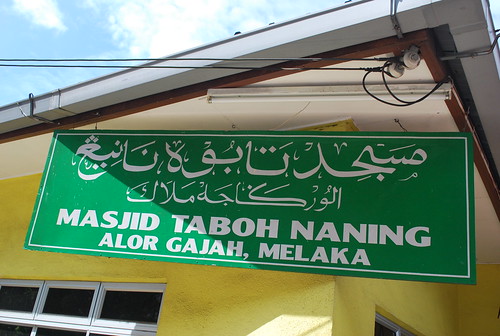
Dol Said’s Mausoleum is located at Taboh Naning, about 32km from Melaka city. The mausoleum is a must visit place with much historical value. Visitors can drive from Melaka town or take the PLUS highway and exit at Simpang Ampat. Dol Said’s Mausoleum is only 2km away from the highway exit. Taboh Naning Mosque beside the mausoleum is the landmark to look out for.

Datuk Dol Said (also known as Abdul Said) was the ninth ruler of Naning District who defiantly opposed the imposition of tax by the British. The British ruler in Melaka demanded Naning District to remit their taxes amounting to 10% of their total harvests, as tribute to Melaka. However, Datuk Dol Said turned down the request because he feels that Naning is not part of Melaka. His valiant resistance against British intervention in Naning brought about the infamous Naning War, which occured in 1831–1832. The British wage a war against Naning in the year 1831 but Datuk Dol Said managed to outsmart the invading forces with the help of his nearby allies.

However, in 1832, the British launch a second attack on Naning with a much larger force. This time, Datuk Dol Said did not acquire help from his allies. As such, Naning district was defeated and conquered, but Datuk Dol Said only surrender in 1834. Although the British won the war, they suffered huge lost and had many soldiers were sacrificed in the battle, among them were George Holdfold Walker. George Holdfold Walker was buried in the British Graveyard in Alor Gajah.

The Naning war had made Datuk Dol Said a hero and earned him a permanent place in the history of Melaka. Datuk Dol Said was given pension every month until he passed away in 1849.
Naning War
The History of the Naning War in Malaysia, 1831-1832
Also known as the ‘Little War’, the Naning War was an important event in Malaysian history, despite the fact that scholars dismiss it as a “more expansive drama”. The war expressed traditional modes of power-broking and opposition, as well as anticipated later political developments in Malaya. From the wider perspective of imperial history, this important but neglected episode of British expansion in the East.
The origins of the Naning War can be directed at the British incursions to the archipelago allowing the territorial acquisition of Penang (1786), Bencoolen and Java (1811), Singapore (1819) and Malacca (1824); but these had ripple effects throughout the region.
Naning was a small inland state of 240 square miles situated ten miles north of Melaka town. Between August 1831 and July 1832, the English East India Company was at war with this state, not so much because of what it worth already, but because of its potential worth – “matters concerning land revenue and jurisdiction were bound up with issues such as agricultural and commercial potential and access to its labour”.
The ‘ultimate cause’ of the Naning War was its status in the eyes of the East India Company – they saw the state as a vassal province whose ruler owed his appointment and authority to them. Indeed, there seems to be evidence for this in the Dutch treaty of 1641 and the British one of 1801. However, the ruler, the Malay people and Minangkabau all saw different.
The ruler of Naning, known by his title of Penghulu Raja Mera, had agreed with the Dutch and then later the British, that he would pay a yearly tenth on his rice crops for acknowledgment of his title, though the British continued the practice of accepting instead a token tribute of rice and fowls. “In 1807, however, in consideration of his role as a mere functionary of the Company, they stripped the penghulu of his right to inflict the death penalty and required him to send capital cases to Melaka for trial”.
In March 1827, the Company sent William Lewis, deputy Resident Councillor of Malacca, to Naning to access the situation. Lewis realised the area’s rich economic prospectives and was horrified at the penghulu's exactions, and so told the Company to enforce their full rights in Naning.
“The war was protracted because Naning was the epicentre of a wider power struggle in the interior. In 1758, the Dutch had signed a treaty with Johor placing the inland states of Sungei Ujong, Rembau, Johol and Naning under Dutch protection … By 1831 the office of Yang di-pertuan Besar was contested. When the new candidate, Raja Labu, came from Sumatra with the usual credentials in 1828, he was backed by the Dato Klana, chief of Sungei Ujong and most senior of the four undang-undang ('lawgivers'), but opposed by Raja Ali of Rembau, an ambitious half-Bugis nephew of Sultan Ibrahim, ruler of the predominantly Bugis state of Sel-angor.
Ali had exploited family quarrels to seize power in Rembau and now felt threatened by the election of Labu, whose wife was Ali's aunt and one of his fiercest foes. Labu was driven to seek political asylum at Melaka, where he was living in 1831 under the title Yang di-pertuan Besar of Sri Menanti”.
It was the British secret meetings with Rembau, Naning’s ally, that allowed them to defeat Do Syed and Nanning. The state was incorporated into Melaka territory and redefined administratively.
The Naning War may be passed over as a minor dispute in Malaysian history, but on closer examination, we can see its true worth. It was a series of interlocking crises which gripped the Malay world and ultimately, the English East India Company.
